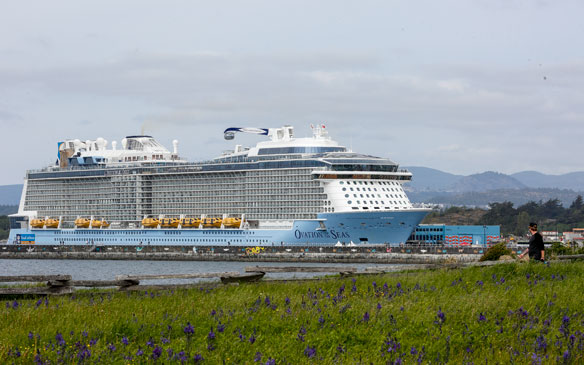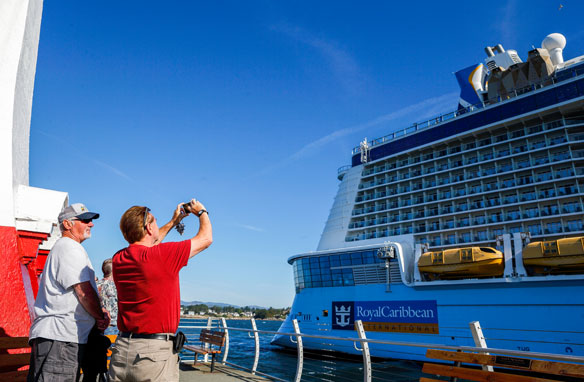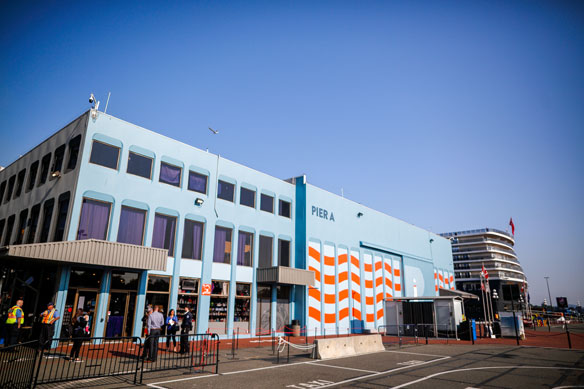
Greater Victoria Harbour Authority prepares for the future

THE CEO OF THE GREATER VICTORIA HARBOUR AUTHORITY (GVHA), Ian Robertson reflects on the impact that COVID-19 has had on the port’s operations so far in 2020 – going from a forecast of a record year to finding ways to keep its losses to a minimum.

Robertson
I’m not a fan of the word “authority” as we technically have no authority over the air or seabed. If we could afford it, I would change our name – however that is for another day!
While many people believe we are a form of government or part of government, we’re a community-based, not-for-profit. In 2002, through divestment of Federal lands, our organization was born. We’re governed by 8 member agencies, including local governments and First Nations, who make up the majority of our board of directors.
This year was going to be a record year for us. We own and operate the Victoria Cruise Terminal, which is where the majority of our annual revenues come from. This year, we expected 300 cruise ship calls, bringing 770,000 passengers and 300,000 crew. Our other facilities, such as Fisherman’s Wharf and our Inner Harbour marinas were anticipating another busy year as well.
All of that changed due to COVID-19.
Can you talk about the impact of COVID-19 on the GVHA’s operations? And how it has changed the outlook for 2020?
When we first heard about the virus spreading throughout Asia, we had a few cruise lines contact us to request some early season calls, mainly in April. They were going to reposition their vessels out of the Asian market early to avoid any negative impacts from COVID-19. All of that changed in March when the pandemic was declared and outbreaks were no longer contained.
On March 13, Transport Canada uspended all cruise visits until at least July 1.
That order was extended to Oct. 31, 2020 in late May.
It is a decision we fully support as health and safety of our community and our cruise visitors is, and remains, our top priority.
How has GVHA responded to the challenges of COVID-19? What steps has it taken to limit the damage at least a little?
Without cruise visitation, we will not see $12.5 million, or 70%, of our projected revenues this year.
To address this shortfall, we had to make a series of difficult decisions including the temporary layoff of some staff (many of whom we eventually recalled thanks to the Canadian Emergency Wage Subsidy), permanent layoff of 8 staff, reduction of expenses, cancellation of capital projects, and shifting operations on our facilities to essential services levels wherever possible.
Thanks to these efforts, we’re now forecasting a $3 million loss for the year; while it isn’t a positive, I am glad that our collective leadership has kept it to this amount.
 Does it have a plan for recovery? Can you talk about that plan?
Does it have a plan for recovery? Can you talk about that plan?
My focus has been two-fold: one, to work with government partners and cruise line executives to understand what will be required to resume cruise in Canada in 2021 and, two, to support our commercial tenants at our properties.
With respect to recovery for cruise, the first order of business needs to address how it can come back safely, for our community and for passengers and crew. I know that discussions continue from all levels of government and all organizations. Following that, we need to ensure our port is prepared to manage guests and crew including arrival and departure, shore excursions, and movement of people. All of this needs to be done with health and safety in mind, in an elevated state from what was standard and best practice in previous years.
When looking at our commercial tenants, we implemented a rent deferral program where these tenants could defer their May to June 2020 rent payments to us up until June 2021.
We’re also working on applications for the Canadian Emergency Commercial Rent Assistance Program where our tenants will pay 25% of their rent for June, July, and August, we will cover 25%, and the federal government will pay the remaining 50%.
Many of our commercial tenants are tourism-related businesses, so I need to lead with empathy and compassion.
We’re all in this together and we’re all suffering from the impact together as well.
What about federal, provincial or municipal government support programs – has the GVHA been able to access these programs? Have they helped?
These programs have been a huge help to us. CEWS has allowed us to bring back staff to help with operations, maintenance, finance, and accounting. CECRA will allow us to help our tenants. For our temporarily and permanently laid off staff, we know that CERB has ensured they can pay their bills.
What additional programs, support do you need going forward?
We would like to see an extension of some of the federal programs such as CEWS and CECRA; while CEWS has been extended to December 31, 2020, I’m not confident that is going to be sufficient. We continue to work with our destination partners to advocate for additional tourism-related supports.
A slight change of subject, but an important one, I think. I noticed that GVHA has a section on its website about First Nations Partnerships. Can you talk a little bit about these partnerships and why they are important to the GVHA as an organization?
For me, this is the most important of our five guiding principles. Both the Esquimalt Nation and Songhees Nation were at the table when the organization was formed. They have continued to be key partners in our success as an organization.
In 2019, we hired a new First Nations Engagement Manager to help guide us through the process of becoming a Canadian Council for Aboriginal Business’ Progressive Aboriginal Relations certified business.
In addition, the organization has updated a commitment to Indigenous relations and to the two Nations with a Leadership Statement on Indigenous Relations and an Indigenous Relations Framework, signed by our team and board.
We’ve also worked to create a new Indigenous Business Directory that we have on our website and available for our community members and partners.
Our procurement process is in the process of being developed to include equity and diversity in our decision-making processes.
Have these partnerships been impacted by COVID-19?
The Songhees Nation, through Songhees Development Corporation, worked with us to bring their popular Songhees Seafood and Steam food truck down to our Inner Harbour property for several days a week.
We’re also working with Songhees Development Corporation on the creation of a virtual walking tour of the Inner Harbour.
GVHA’s First Nations Economic Develop-ment Committee (FNED) strives to increase economic capacity and further reconciliation through collaboration with First Nations. We will continue to provide 1% of our revenues to this committee to help with these goals.
I’m wondering if the GVHA has been in touch with other harbour authorities in other parts of Canada and, if it has, what kind of conversation are you having with them? Are they in the same situation as GVHA? What kinds of challenges are they facing? And, are there plans to work together cooperatively on some of those challenges?
We have been in touch with all our Canadian port partners as well as our US-based partners along the West Coast.
Transport Canada’s suspension of cruise is nationwide, so we’re all in the same situation.
We’re all working collectively to ensure clarity on the resumption of cruise in Canada is achieved, and best practices around enhanced safety and health measures are shared.
A silver lining from COVID is that we’re now engaged more than ever with our national port partners.
However, most of the ports across the country are Federal Port Authorities, and many of these ports also benefit from cargo shipping.
Cruise is 95% of the business at the Victoria Cruise Terminal. We likely see a handful of non-cruise ship calls at the terminal each year.
Last question. Two parts. Part 1: What’s your forecast for when we’ll see a recovery for the industry? Part 2: What keeps you up at night?
I can answer both questions with the same answer: My hope is that cruising resumes in 2021; what that looks like is entirely dependent on how we ensure people are kept safe and healthy, and that our plan is solid.
We cannot sit back and assume that this problem will be solved and that come October 31, 2020 the suspension on cruise will be lifted.
We have to ensure that our voice is heard and that there is a shared understanding of the triple-bottom line benefits of cruise here in Victoria and across the country.
As with everything related to COVID-19, we’re planning ahead and taking nothing for granted.

